November 2008 Archives
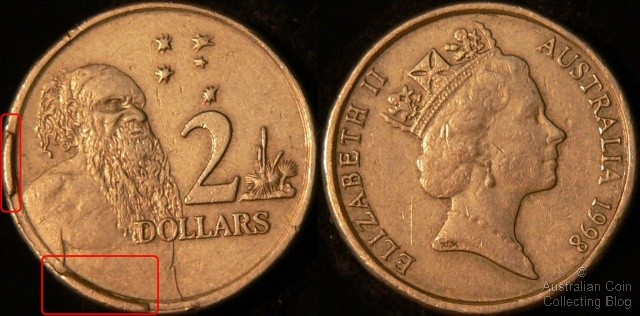
Australia 1998 $2 Rim Cud Error Coin
The so called coin cud or die chip error coin happens when a part of one of the dies that strikes the coins actually breaks off. When this broken die strikes a coin the result is a new raised feature (usually looking like a blob) on the surface of the struck coin that mirrors the incuse feature on the die where the die broke. Coin cuds or die chip errors are reasonably common, and unless the cud is particularly large usually only worth a small premium. A lot of the US Morgan Dollar VAM's are defined by cuds or die breaks and these can often carry a larger premium over the non variety coins.
The most common form of coin cud error is the rim cud, where part of the die that forms the rim of the coin breaks away and any struck coins have a raised element that extends around part of the rim. You can see this coin error on the coin in the image above, the rim cuds on this coin are highlighted in red. In some cases (like the image above) there are actually two cuds. I can only assume that rim cud errors are (relatively) common because the rim of the die is easily damaged in storage and transport. Cud errors can also occur in the main part of the coin design, usually these happen in weaker points of the coin design where part of the die breaks away because of excessive use. These cuds can be smaller and harder to spot, but they still form an interesting variety that some collectors are interested in.
I aware that some collectors differentiate a die chip error and a coin cud based on the size and location of the die chip. To my mind they are the same thing, a raised blob on the surface of a coin because of a coin die break. Assigning some sort of arbitrary size limit between a cud or a die chip seems rather pointless and open to interpretation so I use the terms interchangeably.
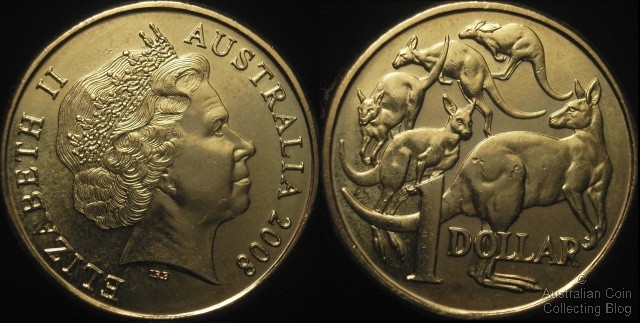
Australia 2008 1 Dollar $1 Mob of Roos
A popular series for collectors and their collections is the Australian one dollar coins issues.The one dollar was first minted in 1984 when the $1 note was withdrawn from circulation. The reverse has the iconic 5 'mob of roos' design by Stuart Devlin. It's composition is 92% copper, 6% aluminium and 2% nickel which is nicknamed 'alum bronze'. It is 25 millimetres diameter and weighs 9 grams. The one dollar coin is often released each year with commemorative designs depicting events of that year.
In 1991 the Royal Australian Mint introduced a new concept where if you visited the mint you could press your own coin on the gallery presses and keep the coin in a special folder. 1993 brought the first of the mintmarked $1 coins where a special letter was struck on the coin either at a show or fair. Also coins were released throughout the year depicting different letters. Often these mintmarks differed only very slightly and it was difficult to determine their origin. These mintmark dollars proved extremely popular with the public and the mint increased their releases to include other alum bronze collector dollars the same size and weight that weren't for circulation. Because of their size and similarities to the circulation dollars they are often found in circulation and are eagerly sought after by 'coin noodlers'. A particular example is the 2000 Victoria Cross dollar which was issued in a special folder at $5 and now retails for $250. These have been known to turn up occasionally in poker (or slot) machines.
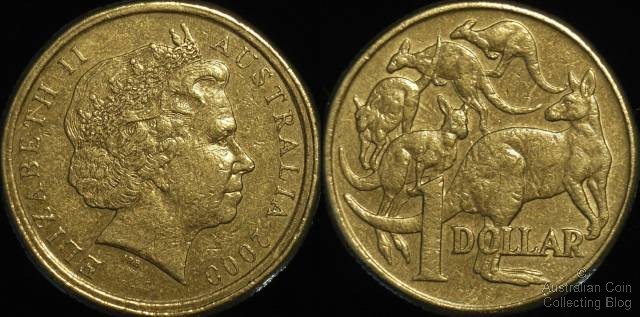
Australia 2000 $1 Mule
In the year 2000 there was a mistake at the Royal Australian Mint during production of the dollars. The "mob of roos" reverse die was accidently partnered with the Queen Elizabeth II obverse die of the Australian 10 cent piece. This 10 cent die was only slightly smaller than the normal dollar obverse die. Coins were released into circulation and to numismatists delight the error was found. These dollars could easily be found in change so the "mule" hunt began. An average example of a mule today could be worth $400 and a high grade example worth $4000.
2006 brought more interest to the one dollar series with the RAM incorporating a new method of production; the pad printed design. This colored series featured ocean animals and is very popular with collectors. Now you would surely notice if one of those ended up in your change! These are NCLT issues not intended for circulation. Read more about this in my previous post.
This year the RAM did a rethink of the term mintmark and introduced some other terms to help distinguish between the dollar coins and where and how they were struck. The terms counterstamp, privymark and mintmark are now used. You can learn about the differences of these coins in my previous post here.
To date there are over a hundred different types and mintmarked coins possible to collect of the 25 millimetre dollar. To collect the entire series of the alum bronze dollars takes a lot of effort and with the mint issuing more and more every year it is becoming difficult on one's wallet keeping up with them all. A new scheme the RAM has come up with involves putting unique dollar designs in mint sets or uncirculated baby sets, forcing collectors to purchase the entire set and break it up just to get the dollar coin. Some of these newer releases seem to be really just novelty coins and haven't proved successful for investment purposes. I might have to rethink my collection..........
There are two mints in Australia issuing legal tender coins and numismatic collectibles to coin collectors. These are the Perth Mint in Western Australia and The Royal Australian Mint (the RAM) in the Australian Capital Territory.
Currently the RAM produces all the Australian circulation issues and these are those coins that you would find in your change. Some decimal coinage was produced at the Perth Mint (1 and 2 cent coins) but these were removed from circulation in 1991 so you wont find these in your change any longer. In the pre-decimal era the Perth Mint produced pennies and half pennies for a number of years and shillings for one year. It also minted gold sovereigns and half sovereigns from 1899 to 1931.
Non circulation issues are referred to as NCLT (non circulating legal tender) which have a legal tender dollar value in Australia but are not standard or intended to circulate. They are not usually recognized by the general population as common currency. The RAM produces a large amount of NCLT and the Perth Mint produce only NCLT as well as tokens, medallions and gold bullion.
Both Australian Mint's happily ship to US customers. You can take a look at the RAM Online Shop here or the the Perth Mint Online Shop here.
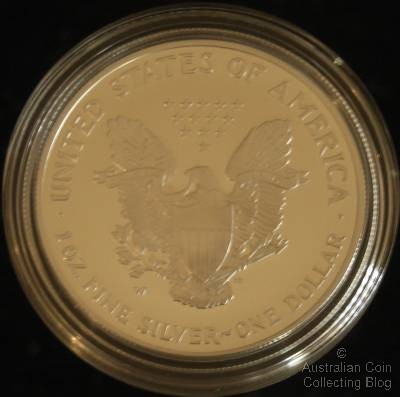
Proof American Silver Eagle in Direct Fit Air Tite Coin Holder
As a follow on to the post I made about ring type air tite coin holders I've decided to post about direct fit air tite coin holders. As their name suggests these coin holders retain the coin securely by the coin fitting directly and securely into the holder and not allowing the coin to move within the holder. The container itself provides an air tight and chemically inert environment to prevent toning of the coin. By retaining the coin securely in the holder the coin cannot move or be damaged.
Coins in direct fit airtite coin holders are attractive and well protected but they pose a problem of storage. Each holder has a different outside diameter and thus they can be difficult to store in a manner that allows them to be easily viewed and enjoyed. The other problem is that you are not guaranteed to find a holder that fits the particular coin you are trying to store. This can result in compromises being made and the coin being able to move about in the holder and possibly be damaged. This can be a particular problem if you are trying to store non US coins as most air tite manufacturers make their holders to suit United States coinage.
February 14th 1966 brought big changes to the Australian population in the way we saved and spent our money. This was the year of decimalization in which Australia moved from the British pounds, shillings and pence to our own Aussie dollar and cents.
The introduction brought a mix of coins and banknotes. Coins issued in 1966 were the round silver 50 cent, 20 cent, 10 cent, 5 cent, 2 cent and 1 cent. Banknotes issued were $1, $2, $10 and $20 with the $5 note being introduced in 1967. These new coin and banknote issues brought a true Australian theme to our currency which wasn't depicted previously. Each year brought more coins and notes but not all coins and notes were minted every year. Some years brought special commemorative issues and design changes. 1969 brought compositional change and a shape change to the 50 cent coin. All coins depict Queen Elizabeth II on their obverse side. With inflation rising in the 70's and 80's there came a demand for higher denomination notes and 1973 saw the introduction of the $50 note and in 1984 the $100 note.
One of the biggest changes was on May 14th 1984 when the 1 dollar note was replaced with a coin. This was because coins have a longer life than notes. Coins generally last in circulation 30 years whilst notes only a few before needing to be replaced. Then on June 20th 1988 a further change brought the $2 coin and the $2 note was withdrawn. This was of concern to the visually impaired who feared that they would not be able to differentiate between the one and two dollar coins. However, it was decided that the $2 coin be smaller, thicker and have intermittent edge reeding so it could be easily identified by touch.
Then in 1992 1 cent and 2 cent pieces became obsolete but were not replaced. We were then introduced to the term 'rounding' where purchases of 1 cents and 2 cents were rounded down and 3 cents and 4 cents were rounded up to 5 cents.
Australian banknotes were originally paper issues but in 1988 Australia introduced the world's first polymer note. We continued replacing all our note issues with the polymer substrate making our country the first to have an entire series of polymer banknote issues.
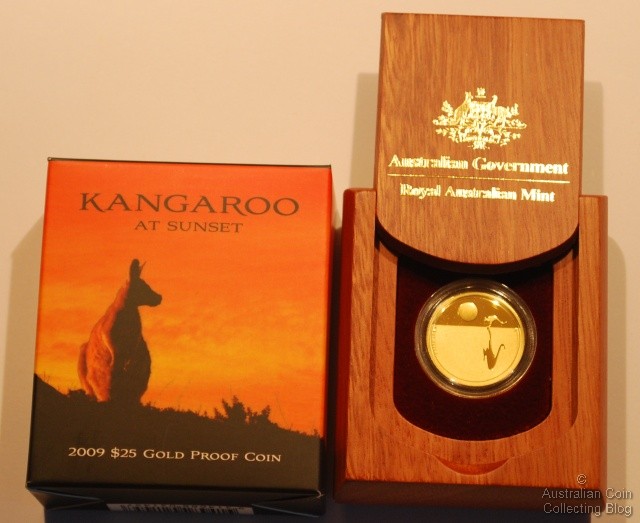
Australia $25 Kangaroo At Sunset
The 2009 $25 Kangaroo at Sunset is the third in the Kangaroo at Sunset coin series released by the Royal Australian Mint (RAM). The 2007, 2008 and 2009 coins all had a 1000 coin mintage. The first two years' coins were sold in the usual manner, through the RAM's website, by phone, and mail order. They sold out in just a day or two and the prices for both have been very strong. The 2007 coin is now selling for upwards of AU$2000 (issue price around $350) and the 2008 coin is selling for AU$700+. These prices have shown a very healthy return on investment for those lucky enough to get one.
In an effort to be more 'democratic' the RAM decided to issue the 2009 coin via a ballot system. People on the RAM's mailing list had an opportunity to submit a ballot entry to purchase one of the 1000 coins. The conditions on the ballot were fairly strict in terms of date of submission and the manner in which the ballot should be filled in. Since the ballot itself closed (on 11 November 2008) the whole process has slipped into what can only be called farce.
Firstly, despite pledging to contact winners of the ballot by the 21st of November no-one at the RAM actually seems to have contacted anyone. The only indication that someone had won a coin in the ballot was a mysterious $395 charge on their credit card. So in spite of their strict terms and conditions on the ballot the RAM didn't seem to mind breaking the rules at their end.
Secondly, some of the 2009 Kangaroo at Sunset coins started appearing on Ebay BEFORE any collector had received a coin. What's more, the same sellers seemed to have more than one coin with consecutive serial numbers despite the ballot stating clearly that you could only purchase one coin. It became apparent that these ebay sellers were actually registered RAM dealers and had got their coins before the average collector had got theirs. What's more the first of these coins fetched very strong prices, over AU$1500 for a coin with a release price of $395. It has now become clear that dealers were allocated coins separately to normal collectors. Following is an exerpt for a RAM letter:
In the case of the 2009 Kangaroo at Sunset coin a small proportion of the total mintage of 1000 was allocated to dealers for pre-purchase through a separate ballot process. Where dealers did not take up their allocation the remaining coins were returned to the retail customers' ballot allocation.
So it turns out that dealers were allocated their coins before normal collectors and in the end collectors DID NOT have access to the full mintage of 1000 coins. What's even worse is that the dealers had access to the coins BEFORE collectors and had the opportunity to get the best prices on ebay. The whole thing seems fairly badly run and perhaps deliberately (or by accident) some information has been concealed from the run of the mill collector. I support the notion of the ballot process but I think the process needs some fine tuning, the RAM needs to stick to their own terms and conditions, and dealers MUST be in the same ballot with the rest of us. These coins are not commodity products like mint or proof sets and (I dont believe) that dealers should be given first bite at them.
Silver bullion is traded 24 hours day around the world and the price fluctuates constantly. The silver bullion investors amongst us like to know what the current price is and how it is varying over time. Personally, I use Kitco for this. The prices are live, you can look at past data in numerical or graphical format, and you can view it across pretty much any time frame you like.
For those of you who dont want to look there the current silver bullion price is US$'.$silver_price.' per troy ounce (Last updated on '.$update_date.' at '.$update_time.')'; echo $string; ?>. This price is taken directly from Kitco and is updated every hour of every day. Happy silver stacking!
If you collect Australian coins or bank notes then you'll know what I mean when I say 'Maccas'. If you dont, then 'Maccas' is 'The Pocket Guide to Australian Coins and Banknotes' which is currently in it's 15th edition and authored by the well known Australian numismatist Greg McDonald. 'Maccas' is essentially the Australian version of the Redbook for the USA or Spinks for the UK.
Towards the end of each calendar year the Australian coin collecting communinity holds it's collective breath waiting for the new guide to be released. Coin collectors cant wait to see what their coin collections are worth and coin dealers (and I am being cynical here) cant wait to re-price their stock in accordance with the new guide. From what I understand Mr McDonald produces the guide largely by himself and it takes a large part of each year to keep up with new releases from the two Australian mints and to monitor the latest price movements. Mr McDonald is a member of one of Australia's more popular internet coin forums and posted a just a few hours ago that the new edition of the guide will be out shortly!
Had quite a few enquiries about the pocketbook. I fly to Sydney this Saturday (November 22) for a full week to oversee the production. All going well it will be ready the first week of December. Please feel free to buy from your favourite dealer. However if you would like a personally autographed copy please let me know. Price is the usual $29.95 plus $5.00 postage. Address is Greg McDonald Publishing & Numismatics, PO Box 649, Lavington 2641.The new book includes all the new issues for both mints. Also included are redesigned layouts for over 200 pages and seriously updated mint locations for
all the predecimal coins. We have also upgraded some 400 photos to add extra clarity. This book has been the biggest overhaul in at least seven years and
has been an almost seven day a week project since July. I hope you will support it and enjoy it.Kind Regards
Greg McDonald
So there it is, it will be out soon! You can say what you like about the guide and it has it's problems, typos and mistakes (which Greg seems to want to fix up) and the coin images in it are just awful (which also seems to have been addressed), Then there are people who suggest that in a small coin market like Australia that the guide actually sets the price of the market for some coins rather than just reporting on it!
Whatever the case the 'The Pocket Guide to Australian Coins and Banknotes' is an essential reference to almost anyone interested in Australian coins and about the best introduction to Australian coin collecting you'll find anywhere.
My last article about the clipped planchet error coin was the outward curcing clipped planchet error coin. I called it this because I really didn't know what else to call it. It's not a common error and not something I'd read about anywhere else before. However, in the last few days I managed to find reference to this type of coin error. It is known as the 'elliptical planchet error', which given the shape of the planchet is fairly self explanatory.

In the image above I've tried to explain (fairly poorly) how the elliptical planchet error occurs. The first coin blank punching operation occurs on the right, and for whatever reason, when the metal strip indexes along under the punching press after the first operation it does not move far enough and the coin blank does not leave the strip. When the next coin blank punch occurs it happens OVER the blank that is still sitting in the metal strip. This forms a crescent shaped clipped planchet on both edges, and an elliptically shapped planchet in the middle. I would guess that the crescent shaped clips do not make it through quality control because they are so small, whereas the elliptical planchet does. And of course a coin is struck on it and the elliptical planchet error coin is formed.
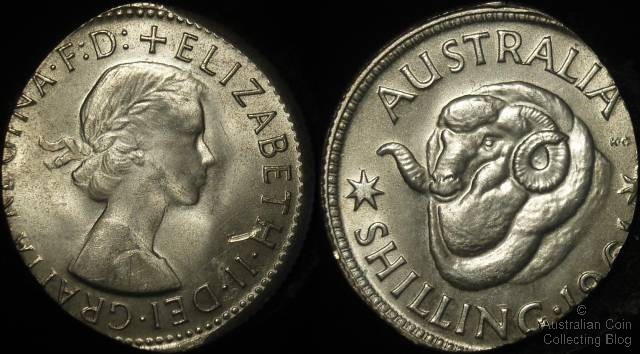
Australia 1961 Shilling Elliptical Planchet Error
There are a few different methods of striking that are used to produce coins. This is different to coin grading which is a method of determining wear. There are 4 methods of producing coins. These are Circulation strikes, Specimen strikes, Piedfort and Proof Coins.
Circulation Coins are struck from working Dies made specifically for the high volume turning out of general circulating currency.
Specimen coins are those coins struck on the same working Dies. These differ however because the planchets have been specially prepared to allow for a better strike.
Piedfort, derived from the French word 'piedforte' meaning heavyweight is struck on a planchet twice the thickness of the regular coin. They are struck as collector pieces.
Proof coins are specially struck coins from meticulously prepared and polished Dies and planchets. These coins are then struck with perfect detail and brilliant surfaces. More recently proof coins are packaged for collectors in capsules and fancy boxes with certificates stating their limited numbers. From 1955 the Royal Australian Mint started to mass produce proof coins for collectors but prior to this proof coins are quite rare indeed. Many earlier coins may have been stored incorrectly, been poorly handled or have environmental damage and toning. A term used for an imperfect proof is an' impaired proof'. This must be taken into consideration when purchasing these coins remembering that proof is a definition of strike and not a definition of wear nor a grade.
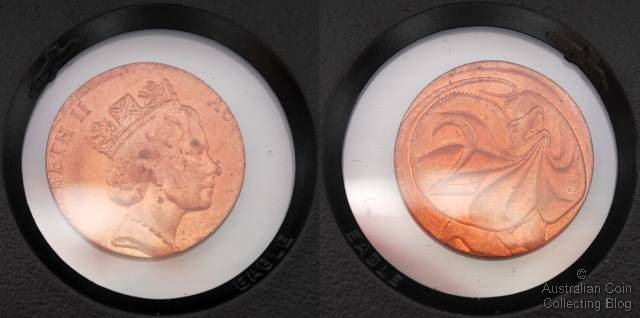
Australian 2 cent struck on 1 cent planchet
One of the scarcer but more spectacular errors is the wrong planchet error coin. These are one of the simplest error coins to explain. Basically they are coins struck on planchets other than the type they were intended to be struck on. This would usually happen because the supply of coin blanks has been contaminated with coin blanks of another denomination. A wrong planchet error coin could be missing details (if it was struck on a smaller planchet), be weakly struck (if it was struck on a thinner or harder planchet than intended), or perhaps show a large area that is not struck at all (if struck on a larger than intended planchet).
The coin above is an Australian 2 cent struck on an Australian 1 cent planchet. The 1 cent planchet is much smaller than the 2 cent so this coin is missing a lot of detail. In this case, the date is missing so this coin is generally not as valuable as a similar grade coin with the date showing. This type of wrong planchet error is one of the more common, with the coin being struck on a smaller planchet belonging to the same currency but a different denomination.
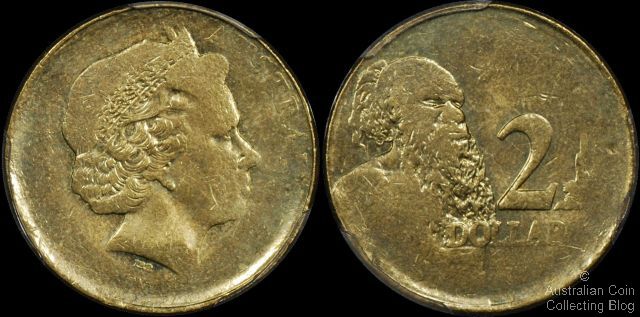
Australian $2 struck on Euro 10 cent planchet
The above coin is a much rarer type of wrong planchet error. In this case the coin has been struck on a planchet of a coin of an entirely different currency! In this case it is an Australian $2 struck on a 10 Euro Cent planchet. In this case the planchet was much thinner than the intended blank and the strike is very weak. In times gone by these sort of wrong planchet errors were very rare indeed, but mints around the world tend to source their coin blanks from third party companies in different countries. These third party companies may have contracts to supply blanks to many different countries and thus contamination can occur. One can only imagine that in earlier times, some of the more bizarre wrong planchet errors (such as US Kennedy half dollars struck on dime planchets) were deliberate 'errors' struck by mint staff.
I've just published the new Australian Shilling site. This site is an extension to the network of Australian coins sites we are publishing, which also includes the Australian Threepence and Australian Florin sites. Please take a look and let me know if you find any factual errors or if there's any information that needs to be added.
As a follow on to my posts about the United States, Australian, and Canadian silver coin value calculators I've expanded the system to calculate bullion values for New Zealand silver coins. Following on with my unique naming scheme I've called it the New Zealand Silver Coin Value Calculator! It works exactly the same as the other calculators but works out values for New Zealand silver coins instead.
As a follow on to my posts about the United States and Australian silver coin value calculators I've expanded the system to calculate bullion values for Canadian coins. Again I've named it imaginatively the Canadian Silver Coin Value Calculator! It works exactly the same as the other calculators but works out values for Canadian silver coins instead.

Australia 1961 Shilling Clipped Planchet
A final class of clipped planchet error is one that I have just seen called a clipped planchet. But, it is much more interesting and scarce than a regular curved clipped planchet error coin. As mentioned previously coin blanks are punched from a metal strip, with the metal strip indexing along under the blanking press as each blank is punched out of the strip. A curved clipped planchet error occurs when a coin blank is punched out before the hole from the previous blank punched out has completely passed the blanking press. This typically results in an inward curving clip which you can see here.
However, you can see on the coin above that the clip is curving outwards. Now, while I am not entirely sure exactly how this coin error is produced I do have a theory that can explain it. This coin error might occur when a coin blank is punched out and the metal strip indexes along, BUT, it only moves along less than half of the width of the coin blank and BEFORE the previously stamped blank has dropped from the coining strip. Thus, the coin blank is stamped again, breaking the planchet in two, one piece would be a crescent moon shape, and the other the sort of shape you see above.
I'm going to call this error the outward curved clipped planchet error coin.
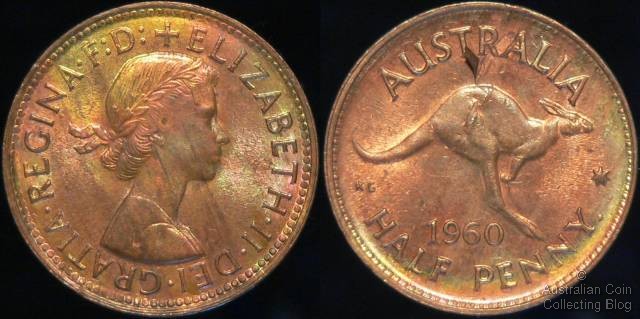
Australia 1960Y Half Penny with attached peel
An interesting (but not particularly scarce) type of coin error is the lamination flaw error or the peel error. A lamination or peel coin error occurs when there is some sort of impurity in the metal of the coin planchet just below the outside layer of the coin. This impurity stops all of the metal in the coin bonding together correctly. Because the layer of impurity in coin is just below the surface the thin layer of metal between it and the surface can become become either partially or totally detached from the rest of the coin.
I am not sure if there is an official distinction between a lamination flaw error and a peel error, but I like to define them as follows:
Lamination Flaw Coin Error: I like to think of this error as one where the thin layer of on top of the impurity metal from the coin has not really detached from the coin. These errors appear to have very slight flaws or cracks in the surface of the coin that generally are quite long.
Peel Coin Error: I like to think of this error as one where the thin layer on top of the impurity metal from the coin has completely or totally detached from the surface of the coin. In the above image you can see a peel on the reverse of the coin that is almost completely detached from the coin.
On a closing note, the lamination flaw coin error or peel coin error is closely related to the split planchet coin error. Both are caused my impurities or flaws of the coin planchet and result in all or part of the metal of the planchet detaching from the rest of the planchet.
Aluminium bronze one dollar coins issued by the Royal Australian Mint from 1993 began to feature a mintmark. Initially the mintmark was a letter C, S or M and later B, E, A, and TV mint marks appeared. Initially the mintmarks represented a capital city of Australian but the later E and TV mintmarks were simple marketing exercises. Mint mark dollars were either minted on the coin presses at the mint in Canberra, or had the mint mark applied on a smaller portable press at various coin shows and events around the country. At this point the coin collector with a nose for history will realise that the coins minted with a mint mark in Canberra were not using the term 'mint mark' correctly, after all a mint mark is supposed to represent where a coin is minted. So a B (representing Brisbane) mint mark coin minted in Canberra is really mis-using the term mint mark for that coin. However, a B mint mark coin having the mint mark applied on a portable coin press at a coin show in Brisbane is closer to the original idea of what a mint mark was to represent. However, even this is not a true mint mark as the mark is just being applied in Brisbane, the coin itself was minted in Canberra.
Because of this confusion and with the ever increasing popularity of the mintmark series, 2008 brought rise to a new series of marks to identify coins and locations. I'll try to outline these new terms and their definitions. The Royal Australian Mint is now releasing aluminium bronze dollars with mint marks, with privy marks, and with counter stamps.
The mintmark will continue to be used by the mint but it will be a mark on the original die that denotes the actual location where the coin was struck. Most commonly this mint mark is a raised letter on the coin with no surround.
The privy mark was first used on the British coinage of King Edward III. These were secret marks showing the period in which the coin was struck. Adapted for today's coinage the privy mark today signifies specific sets, designers, special events or commemoratives. The one dollars produced by the RAM with dies that have been modified with a letter or symbol are now referred to as privy marks. These are a letter or symbol with a square surround. This does not denote being struck at any particular location.
The counterstamp is a mark on a coin that has already been struck with it's design. Previously also referred to as "countermarks" these were used throughout history. The first fleet (which arrived in Australian in 1788) arrived with many world coins which were countermarked. The aluminium bronze dollars are struck at the mint and then counterstamped later at various shows and fairs around the country. These are identified by letters with a circular surround.
I hope that helps to clarify what is initially a confusing set of terms and marks on the collector dollar coins in Australia.
We've written an updated article with images for further reading: Identifying One Dollar Mintmarks, Privy Marks and Counterstamps
I've made some changes to the Australian Silver Coin Value Calculator and the United States Silver Coin Value Calculator. Along with the silver price, the calculator now downloads the US Dollar exchange rate for various currencies hourly. You can now select a currency (US Dollar, Australian Dollar, Canadian Dollar, Euro, or English Pound) for the calculator to use. The value of the silver content in the coins will be automatically displayed in your selected currency, and the calculator will remember what currency you had selected the last time you used it.
As a follow on to the last post about the United States Silver Coin Value Calculator I've expanded the system to calculate bullion values for Australian coins. Again I've named it imaginatively the Australian Silver Coin Value Calculator! It works exactly the same as the first calculator but works out values for Australian silver coins instead.
Stay tuned, there'll be more calculators coming up soon, Canada and Great Britain are my next targets.
I've spent a bit of time creating a calculator to allow you to work out the silver content (and value) of United States coins. I'm calling it (funnily enough) the United States Silver Coin Value Calculator! It should be very simple to use, just enter the numbers of each coin that you have and it will automatically output the total silver content in ounces and the silver value in US dollars. The calculator grabs the silver price from Kitco every hour, so the value you get for the silver bullion content of your coins is pretty much up to date!
Coin collecting or numismatics, is generally largely dominated by older men. Getting women and younger collectors interested in the hobby is essential to keep it alive and vibrant. Here are some ideas you might like to use to get kids interested in the hobby.
- Firstly you need to teach your children to identify the different types of coins in your change. Give them some change to look through and point out the different coins, colors, sizes and shapes. You will want to show them where the dates can be found on the coins.
- Let them look through your change and get them to find coins from the year of their birth.
- Let them look through your change and get them to construct year sets from circulation.
- Take a look at your country's mint (where they make the coins) and see if they have any products specifically suited to young numismatists. For example the Royal Australian Mint has a product specifically designed for young or beginning coin collectors. The US Mint has an entire section of their website devoted to kids.
- Look at purchasing them a coin album such as a Whitman album with a hole for each coins of the specific coin series they are collecting from circulation. You can challenge them to fill the holes and they'll have a goal to work toward.
- Take them to a coin show, often children who show an interest in coins will be given a small free gift from the friendly dealers in the hope that they will gain a future customer.
Above all remember to show enthusiasm for their new hobby. Children thrive on praise and people showing an interest in what they are doing. If you continue to help them with their interest they'll gain a rewarding an interesting hobby that could last a lifetime.
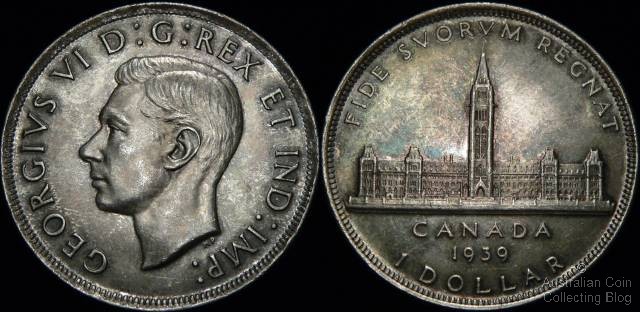 Canadian 1939 1 dollar
Canadian 1939 1 dollarThere are misconceptions amongst amateur coiners that a coin must be shiny and bright for it to have value and appeal. After all, current new coin issues are brilliant and perfect. Old coins however have weathered the world, they may have sat in a drawer or a bag for decades, even hundreds of years. Through this time climate and storage will have always affected these coins to some degree. Coins over time may develop lovely patina, deep rich toning or a mottled toned appearance that can have fabulous eye appeal. Rainbow toned coins may also bring a premium price and are very collectible. This magnificent aging should be of value to your coin, not it's detriment.
This can be a very touchy subject when it comes to coins and banknotes too as the general consensus is not to clean coins at all.
So you've found this hoard of coins stashed away for decades and they look a bit grubby. Some are crusty with dirt and green and others are unrecognizable. You'd like to make them look better before you take them to show anyone who may want to buy them.
If any of your coins have a green areas or spots then it is best to remove these coins to a "quarantine" area. This green is called "verdigris" and is like a copper cancer or can develop from pvc residue on coins. It will grow with time and spread to your other coins. Verdigris is very difficult to remove so this is often fatal for the coin.
Coins that are obviously dirty can be run under water (with a very mild detergent) and left to air dry. A short soak in olive oil may remove unwanted gunge. For cleaning corroded coins the damage is already done, they will forever show pitting into the coin surface. This is as far as anyone should go with cleaning. Never rub your coins, this will scratch the surface. If a coin has terminal verdigris it may benefit from a longer soak in olive oil and maybe a gentle prod with a wooden toothpick. This might damage the coin minimally but with the verdigris it's value was limited anyway.
If you came across a valuable coin with verdigris I would always turn to an expert dealer for help. There are many myths including inserting your coin into a potato to clean it which I have never had any success with.
I have heard many a horror story about valuable coins being ruined by using the wrong cleaning methods. The simple answer to cleaning questions is DON'T CLEAN COINS. Just a simple rub with a cloth can put hairline scratches on a coins surface that will damage the coin for good. You might not see these scratches with the naked eye but they are easily visible under magnification. Soaking or washing coins in cleaner or coke or silver dip can remove toning and really "brighten up' your coins but this isn't how coins are meant to look. This can give copper coins, for example, a salmon coloring which is neither natural or appealing. For silver coins this can give them a blast white appearance and can impair the natural cartwheeling lustre of silver coins. Cleaning coins in this way removes the top layer of the coin thus degrading it permanently.
There are many specialized coin cleaning products out there for cleaning old coins from silver dips to fake toners. I would avoid these at all costs. The end result will only be a fake looking coin that is worthless.
For the amateur it is best not even to attempt any cleaning as the potential for damage to your coins is huge. Even coin experts have been known to purchase valuable coins only to find out later that they have had some attempt at cleaning.


